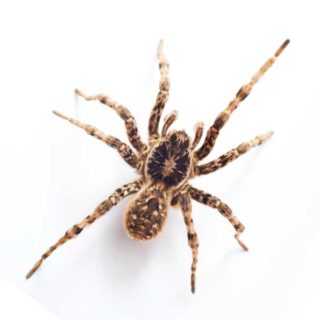Identifying Brown Widow Spiders in Florida
Brown widow spiders, also known as cobweb spiders because of their irregular webs, are common in Jacksonville FL. The brown widow originally entered the U.S. in Jacksonville FL and spread its range in the 1990s. The brown widow resembles the black widow, however, the hourglass of the brown widow is yellowish-orange or reddish-orange instead of bright red as in the black widow. Males do not bite, however, the female brown widow is a venomous spider that injects a neurotoxic venom when it bites its prey.
Additionally, brown widow spiders often have geometric patterns on their backs and legs, adding to their distinct appearance. The legs of a brown widow spider may also have dark bands. Their size is comparable to that of other widow spiders, with females measuring about 1.5 inches long, including the leg span, while males are generally smaller and less noticeable. Recognizing their web is another important aspect of spider identification. Brown widow webs are irregular and messy, typically found in secluded, sheltered areas like outdoor furniture, garages, or window sills. These tangled and sticky webs are designed to trap unwary insects, distinguishing them from the orderly orb webs of other spiders.
Where in Florida Do Brown Widow Spiders Live?
The brown widow builds its web in secluded, protected sites around homes and in woody vegetation with branches. Some typical sites selected by brown widows for web building are empty containers such as buckets and nursery pots, mailboxes, entryway corners, under eaves, storage closets and garages, and on the undersides of outdoor furniture and wrought iron railings. They choose places that are more exposed than sites chosen by black widows and therefore, appear to be at higher risk for interactions with humans regarding the potential to be bitten.
Brown widow locations are not limited to a specific part of Florida. They are widespread throughout the state, from the Panhandle to the Keys. This widespread distribution means you could encounter these spiders in a bustling city or a quiet rural area.
How Common Are Brown Widow Spiders in Florida?
The prevalence of brown widow spiders in Florida has increased in recent years. They are becoming increasingly common, which makes it essential for residents to be aware of their presence and take steps to manage them.
Brown widow spiders have adapted well to the human environment in urban areas. They are often found in residential neighborhoods, parks, and other places with plenty of cover and food. Their adaptability and the abundance of suitable habitats contribute to their growing numbers. Brown widow spiders are also common in rural areas, particularly in areas with plenty of vegetation and sheltering structures. Farms, barns, and other agricultural settings can provide ideal habitats for these spiders.
Despite their increasing numbers, brown widow spiders are often overlooked because they tend to stay hidden. They are not aggressive and will typically retreat when disturbed. However, their growing presence means that more people are likely to encounter them, making it essential to know how to identify and manage them.
Are Brown Widow Spiders Dangerous?
The bite of a brown widow spider is minor in comparison to that of a black widow and does not cause the same symptoms as a black widow bite. Brown widow spider venom is twice as potent as black widow venom, however, it is believed the brown widow does not inject the same amount of neurotoxin. This species is timid and avoids human interaction. In fact, males and immature brown widow spiders do not bite at all. While brown widow spider bites are typically not medically threatening, it is important for sensitive individuals to seek medical attention in the event of severe pain and swelling.
If you are dealing with a brown widow spider problem in your home, contact your local spider exterminators for help.
Need help with Brown Widow Spider control?

Leave your information below and we’ll be in touch with a FREE quote!
"*" indicates required fields
*During normal business hours. After hours calls will be returned the next business day.
FAQs
How Do Brown Widow Spiders Differ From Black Widows in Florida?
Brown widows are light brown with an orange or yellow hourglass marking, whereas black widows are shiny black with a red hourglass marking. Brown widows often have geometric patterns on their bodies, unlike black widows. They are less aggressive and create irregular, messy webs, while black widows’ webs are more structured.
Can Brown Widow Spiders Cause Health Issues in Florida?
Brown widow spider bites can cause localized pain, redness, and swelling, with potential symptoms like muscle cramps, nausea, and headaches. Severe reactions are rare but can occur, particularly in vulnerable individuals. Most symptoms subside within a few days with proper care. Brown widows are not aggressive and bite only when threatened. If bitten, clean the area with soap and water, apply a cold compress, and seek medical attention if symptoms worsen.




